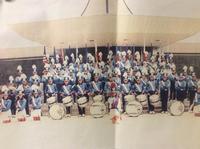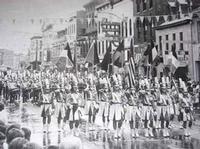Cambria Cadets
Ebensburg, PA United States
Founded: 1962
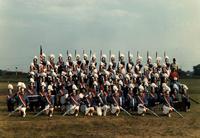
| Year | Position | Score | Theme/Songs |
|---|---|---|---|
| 1972 | Four Part Suite in B minor * Battle Hymn of the Republic * American Patrol * If We Only Had Love * South Rampart Street Parade |
CORPS Photos
The Cambria Cadets drum & bugle corps was born in the fall of 1962. The organization was an outgrowth of the Legion Airs senior drum & bugle corps, led by the founding director Horatio B. “Rash” Isenberg Jr.
The first appearance of the Cadets occurred at the Ebensburg Memorial Day Parade in 1963. The Cadets marched solely as a parade corps for the initial year and utilized instruments from the Legion Airs with red, yellow, and black uniforms from the Gardner Guards of Tyrone. In its second year of existence, the now familiar red, white and blue color scheme was adopted. 1964 brought the organization to their first VFW parade state championship as they entered their first field show competition in Lock Haven in August.
During the first few years, the Cadets transitioned from being predominantly a parade corps to a field show corps. During this era, even
By 1966, the Cadets had grown and established a solid reputation throughout western PA. It was also having growing pains as the activity, as a whole, was moving from a quasi-military pageantry activity to a more musical and visual activity. That year, they finished 5th at the PA AL state championships and 6th at the VFW state contest. The following season, the Cambria organization took, for them, a giant step by joining the Penn-York circuit. The activity had begun to fundamentally change and the number of local, hometown corps had declined in western PA, which meant fewer local contests. The Penn-York Circuit solved a couple of problems for the Cadets.
First, it provided the number of competitions needed; and second, it opened the organization, the instructors, and the members to new ideas, new philosophies, and new approaches from junior drum corps from all over the state of New York. Arguably, hooking-up with the Penn-York circuit was the most significant growth activity in the evolution of the Cambria Cadets. At the 1967 Penn-York circuit championships, the corps finished in 2nd position. They also finished 4th at the American Legion and 8th at the VFW state championships. One could feel the growth and determination of the corps increase from week to week and that drive held over to the winter rehearsals. No one was looking back and the little corps from the little town of Ebensburg was going head on with Penn-York contenders.
The Cambria Cadets became one of the most popular activities for children in the community. A typical example is that girls who wanted to join the color guard would routinely come to practice and show their interest for a year, before even applying for membership. The corps was beginning to develop a regional draw for members. In addition, that core group of members who used to be 12 now was 16 and 17. Simply, they had the experience and could play and march better. The stature of the organization was ingrained in the drum corps activity both in the states of Pennsylvania and New York.
However, the championship flags had eluded the corps to this point. Everyone wondered if the Cadets would always be the bridesmaid. New branches of the activity were emerging like the winter competitive color guard. The Cadets entered that activity and became quite successful throughout western PA. Consultants and other specialists were brought in to the organization and infused new ideas to the performers and staff. It was, to borrow a phrase - the best of times. There was a sign erected at the borough limits saying - Welcome to Ebensburg, home of the Cambria Cadets.
The corps even sponsored an annual winter color guard competition, in the spring that took on a dual purpose – obviously, the regional color guard competition but also, the unveiling of the Cadets new repertoire. That caused a swell in attendance as enthusiasts and corps staff from the region packed into Bishop Carroll’s gymnasium to get a sneak peak at what the Cambria Cadets were playing for the upcoming year.
1968 was a solid and exciting year for the corps. The Cadets finished first or second in most of the competitions. There were many who thought this might be the year for the American Legion and VFW state championship. However, it was not to be. Although disappointed, the organization was strong and morale skyrocketed as the corps entered into its remaining competitions of the season. The 1968 Penn-York circuit championships was held in Syracuse. A long trip! Transportation rarely used, chartered busses. A long preliminary competition, then they competed at the finals that evening. When all the dust settled, the bridesmaid was now a full-fledged bride. The corps members were initially in shock, but stoic at the retreat, pretending like it was no big deal. It was a big deal and afterwards, only one word could describe it – euphoric! What a way to end a season! It was also a galvanizing event for the members. Members pledged that next year would be even better.
The performers probably couldn’t articulate their feelings at the time. In retrospect, it was synergy; the notion that the “whole” is bigger than the sum of its parts. Returning from Syracuse to the ‘burg’ at the dawning of a new day, the convoy was met outside of the town with rows of cars of well wishers on the side of the road, honking and waving and ready to make that convoy bigger and to celebrate the collective success of a little town.
It is fair to say that the winter of ’68 and spring of ’69 was an inspired time for all involved. Expectations ran high. Practices were frequent, long, and arduous. Driven! The season was wonderful, winning many shows and placing a close second in a few. The administration of the corps made certain that the Cadets got some early exposure to some of the other judging associations that might be adjudicating at the state championships. The Cadets traveled to the state capitol, Harrisburg, and the VFW state championships. The corps left the afternoon before, getting prepared for the preliminary competition the next day. All the powerhouses from the east were there. The unit put on an inspired performance. A new state champion was declared – the Cambria Cadets. The next day, marching in the parade beside the PA state Capitol the corps approached a long line of black, gold, and white uniforms applauding and saluting the Cadets – the York White Roses. At last, a well deserved recognition from their home state.
The American Legion championships was held a week later in
What can be said about the Cadets in the‘70s is mirrored in the fabric of the decade. That core group, mentioned earlier, were now 18-19 - some went to Vietnam, some went to college, some moved on to the workforce and some had other priorities that prevented their further participation. War. Peace. Change! And the activity itself was switching into hyper-speed for change. All of the conventional standards were “on the table” for scrutiny. Even in Ebensburg the change was felt. During that time, the rules required every corps, during their field show, to perform a selection commonly known as a color presentation where the American Flag was honored. Typically, that was a patriotic selection like ‘The Stars and Stripes Forever.’ For two years running, beginning in 1970, the Cadets color presentation was a song titled - Let There Be Peace on Earth.
The activity was changing in other fundamental ways. The American Legion and VFW had, traditionally, written the rules for the drum corps activity. They proscribed where a corps started on the field and where the corps ended, and basically the entire scope of a show. A group of very influential people in the activity began to question those parameters. Their premise was fairly simple: Why don’t we change the rules so that the performances can be more musically and visually exciting to the audiences and more engaging for the performers? Their requests for change were met with an unreasonable, stuck in the mud answer – NO.
In 1970, the corps’ season was highlighted by one last PA VFW state title and a 7th place finish at the AL state championships. The next three seasons were a turning point for the Cadets organization. The desire to compete was clearly present but the capacity could not be mustered. As many things do, much of it came down to money. The organization was still strong and trying to figure out ways to adapt in a quickly changing environment. This included new staff. As that core group of performers exited in the early ‘70s, they were replaced by a younger, but no less determined group operformers.
Throughout many of these years Leona Sowers was president of the corps and as it was in the 1960’s the fundraising and hoagie sales to support the organization were prolific. As the 70’s creped into the ‘80’s and the cost of operating dramatically increased with soaring interest rates, all non-profit groups were hard hit. The corps reverted to a parade corps for the 1980 and 1981 seasons before returning to the field of competition in 1982 and finally 1983, their last competitive year. Both seasons, they participated once again at the AIO “Class A” prelims, finishing 27th and 29th respectively. They also competed at the 1982 DCI East preliminaries, placing 14th.
The corps declined in membership and by 1984 decided to revert back to a parade corps. That was the final year for the organization, disbanding in 1985. The Cambria unit had a long and proud history where hundreds of young lives were fundamentally changed for the better.
Cambria Cadets Alumni website; Paul Legault (DCX)
-
1964 1 scores
Highest Score 71.330
Final show in DCX Archives August 15, 1964 Lock Haven PA placed 3 with a score of 71.330
-
1965 2 scores
Highest Score 72.300
Final show in DCX Archives July 16, 1965 PA American Legion State Championship Pittsburg PA placed 4 with a score of 53.600
-
1966 3 scores
Highest Score 70.270
Final show in DCX Archives July 22, 1966 PA State American Legion Championship Hershey PA placed 5 with a score of 56.583
-
1967 3 scores
Highest Score 67.150
Final show in DCX Archives August 19, 1967 13th Annual Cavalcade of Music Marion OH placed 4 with a score of 66.600
-
1968 3 scores
Highest Score 77.100
Final show in DCX Archives August 31, 1968 Music In The Valley Johnsonburg PA placed 3 with a score of 59.450
-
1969 8 scores
Highest Score 73.750
Final show in DCX Archives August 30, 1969 Music in the Valley Johnsonburg PA placed 4 with a score of 62.000
-
1970 5 scores
Highest Score 62.950
Final show in DCX Archives August 29, 1970 Ephrata PA placed 2 with a score of 62.950
-
1971 2 scores
Highest Score 60.950
Final show in DCX Archives July 17, 1971 Brentwood PA placed 5 with a score of 60.950
-
1972 1 scores
Highest Score 54.150
Final show in DCX Archives June 3, 1972 Auburn NY placed 3 with a score of 54.150
-
1973 1 scores
Highest Score 41.750
Final show in DCX Archives June 23, 1973 Penn State Open Championship Finleyville PA placed 4 with a score of 41.750
-
1974 2 scores
Highest Score 42.350
Final show in DCX Archives July 31, 1974 Swissvale PA placed 5 with a score of 42.350
-
1975 2 scores
Highest Score 45.000
Final show in DCX Archives July 12, 1975 Beaver Falls PA placed 5 with a score of 38.550
-
1976 1 scores
Highest Score 0.000
Final show in DCX Archives July 24, 1976 Polish-American Days Erie PA
-
1979 4 scores
Highest Score 43.450
Final show in DCX Archives July 29, 1979 Latrobe PA placed 6 with a score of 38.450
-
1980 1 scores
Highest Score 74.150
Final show in DCX Archives July 9, 1980 IDC Show Huntington PA placed 4 with a score of 74.150
-
1982 3 scores
Highest Score 51.000
Final show in DCX Archives August 9, 1982 American International Open Class A Butler PA placed 27 with a score of 27.600
Members (3)
| Member Name | Section | Years Involved |
|---|---|---|
| Blair, John | Percussion | 1963 to 1973 |
| Mergen, Derrick | Horn Line | 1964 to 1973 |
| Summerson, Lynn | Percussion | 1969 to 1973 |
CORPS 2 items
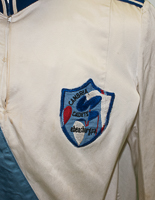
Cambria Cadets Uniform 1991 from the Bill Ives Collection Contributed by Mike Clawson
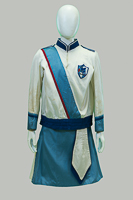
Cambria Cadets Uniform 1991 from the Bill Ives Collection Contributed by Mike Clawson
LOADING.....

